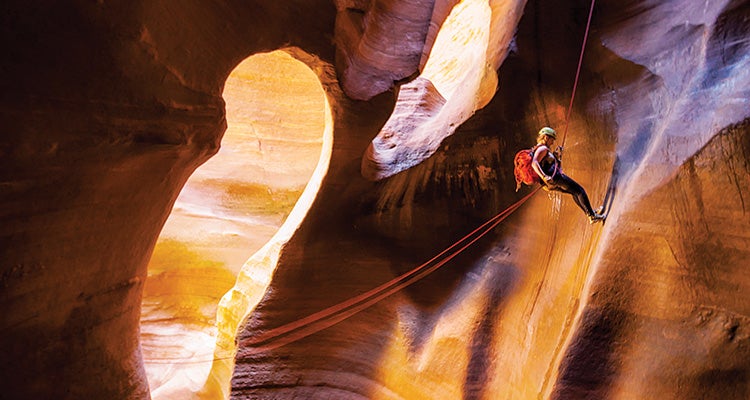Depth of Field: Canyoneering

'The Great Cathedral rappel in Pine Creek Canyon in Utah's Zion National Park (Bergreen Photography)'
A thin strip of light filters down from above, framed by 400-foot cliffs that press inward to form this deep, narrow gorge. Nathan, my helmet-clad companion, squeezes through the rappel start, then glides down to land beside me in a puff of dust. He unclips, turns to me, and asks, “Pull ’em?” I nod yes. He hauls on the rope until it unthreads from the anchor and lands, with a slap, at our feet. That’s the sound of commitment.
We’ve studied the route, we know our beta, I’ve even been here before, but as sure as gravity, we’re met with a heady realization: Now there is no retreat. Our only way out is down this tight slot, hidden in the remote Robbers Roost country of southern Utah. The stone corridor winds seductively out of sight below us, ever deeper, darker, and more hushed.
Technical canyoneering routes are almost always one-way trips—down—due to the smooth, polished nature of water-carved cliffs. Simply put: There’s no going back. But while you have to finish, you can never be totally sure what that will entail. Rain cycles turn hallways into boulderfields, beaches, or mud flats; logjams shift and vanish; rappels might suddenly end in deep pools, while potholes can change from an easy swim to a smooth-walled, test tube-shaped trap (called a “keeper”). Or you could get your rope stuck on a rappel pull and be stranded.
I guide canyon trips now, but I learned all this the hard way. By the early 90s, I already had a couple decades of rock climbing experience when a friend and I wanted to try canyoneering and decided on a 33-rappel, overnight canyon in Zion National Park. We thought we knew what we were in for, but didn’t realize that low water levels would create an endless series of keeper potholes. We floated for hours, shivering in 380F water despite being swaddled in neoprene and dry suits, trying to grapple-hook our way out using bent carabiners. Once I warmed up, I wanted to get back in a canyon, but stuck to the straightforward “easy” ones for a very long time.
Why did I work my way back to the tricky stuff? For my money, slot canyons are the most beautiful and alluring type of terrain around—the photo on the previous page alone will inspire some people to pack their bags and coil their ropes. From above, most slot canyons look like ho-hum ditches. But drop in and you enter a sculpted underworld of shape and color; cathedrals of golden light, dark, brooding hallways, shimmering pools, lush pocket jungles brimming with delicate flowers. Canyoneering is a poor man’s space shot: a way to travel through spectacular and exotic environments. Recognizing the beauty is easy enough. But you have to respect the beauty—or it can bite you.
Back in Robbers Roost, Nathan and I use cross-pressure between the walls, following bobsled twists carved into these petrified, Jurassic-era dunes. Sunlight bounces down into the gorge, getting redder with every volley until the slickrock ignites in a warm lava glow. It’s far too tight to wear our daypacks. So we drag them while chimneying, back against one wall, knees, toes, and elbows against the other.
The gorge shifts abruptly from squeezy to staircase-steep, plunging us down a series of rappels anchored by deadmen (rocks slung with webbing and buried in sand). When a massive boulder pile blocks our route, we crawl through the “birth canal” at its base and slither into an 18-inch-wide corridor.
The crack widens into a hangar-size cave. Yee-haw! Scouting info and personal experience say our challenges should be over. We peel harnesses, coil rope, and stroll around the corner to stumble upon—surprise!—a wall-to-wall pool of dark, skanky water. Beyond the first pool, another foul lake winds out of sight, rippling sluggishly in the gloom.
This canyon was my idea, so I go first. It’s dark, scary, absolutely frigid—and totally awesome. Once I get used to the stew-like consistency, it feels refreshing, almost. Here, up to my neck in it, I find the Zen-like ability to accept setbacks and surprises, that core requirement for happy canyoneering. The obstacles may be many, difficult, and even different from what you expected, but that’s the price of a return ticket through these hidden worlds.
And the fare is definitely worth it.
Contributing editor Steve Howe runs Red Rock Adventure Guides in southern Utah.
Play the slots
Five spots for aspiring canyoneers
By Ian Bagley and Katie Campisi
NON TECHNICAL
Willis Creek, Grand Staircase-Escalante National Monument, UT
This 4-mile (round-trip) hike follows a shallow watercourse beneath sandstone walls that rise up to 300 feet.
Time 4 hours Infout.blm.gov/monument
TECHNICAL
[Easy]
<strong<Keyhole Canyon, Zion National Park, UT
Combine downclimbing, swimming, and four rappels up to 30 feet (two rappels are on fixed anchors) in this slot in the heart of canyon country. Go in late summer when water is warmest.
Time 1-2 hours Infonps.gov/zion
[Intermediate]
Oak Creek Canyon, Ouray, CO
A handful of 80-foot rappels in the middle canyon give way to a free, 170-foot drop beneath a waterfall in the lower.
Time 5-8 hours Infocoloradocanyons.org
[Advanced]
Heaps Canyon, Zion National Park, UT
A series of narrows and rappels that end in swims lead to the finale: a 280-foot, free-hanging descent to the edge of Upper Emerald Pool. Caution: Low water levels can result in keeper potholes.
Time 12-20 hours Infonps.gov/zion
[Expert]
12 Gauge Canyon, Oahu, HI
The tallest of 15 drops is 400 feet down slick stone under a waterfall. The gnarly first descent wasn’t completed until 2013.
Time 15 hours (first descent) Infounrealhawaii.com